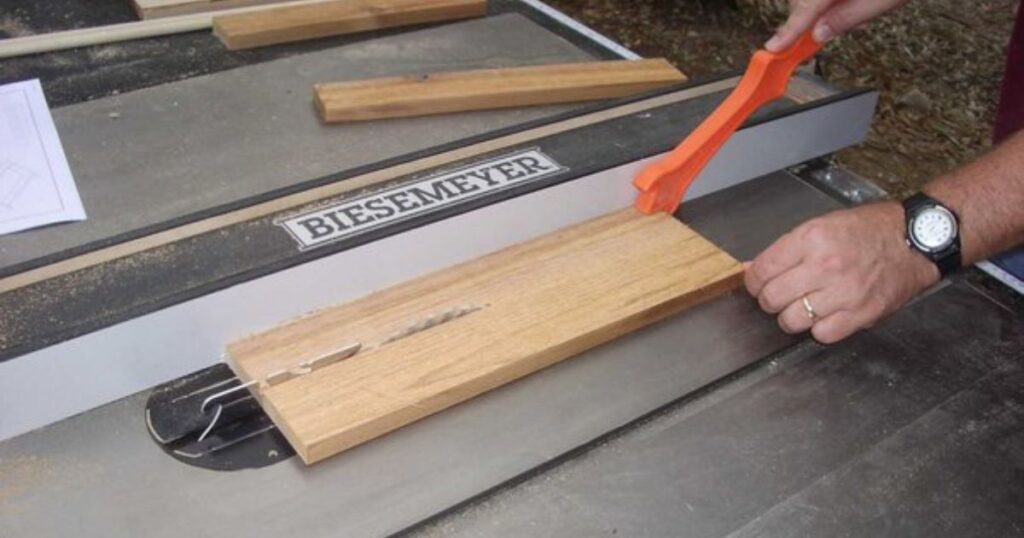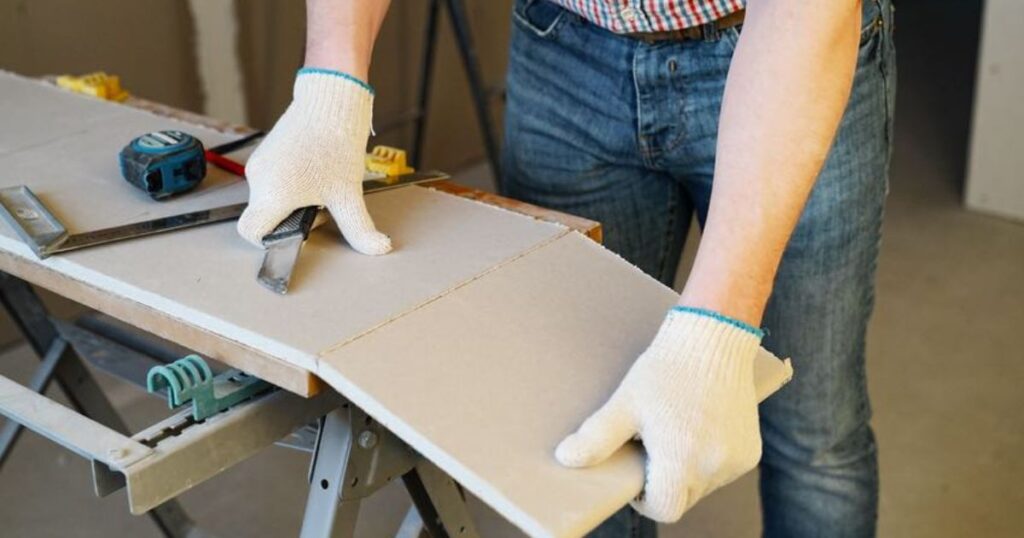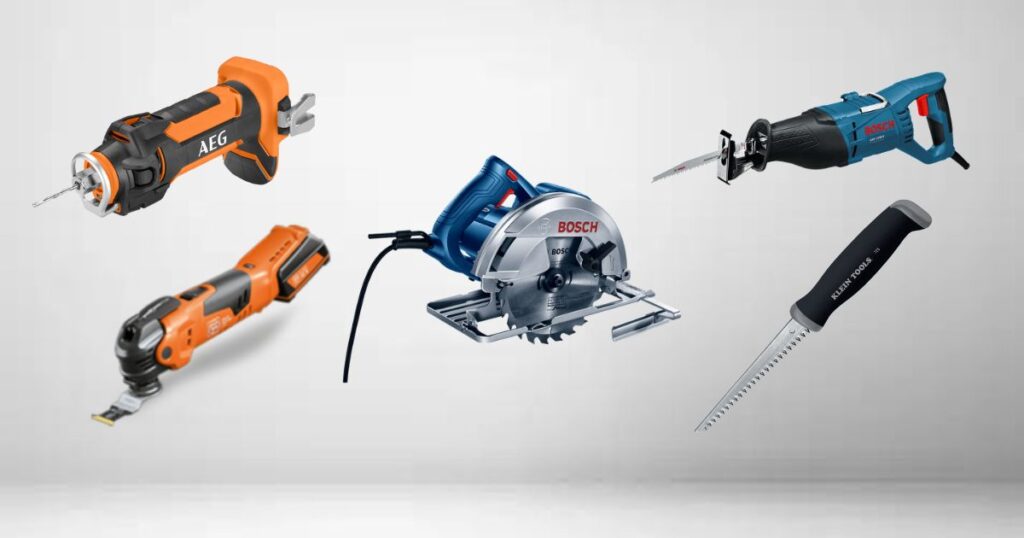We’ve often thought about the question “Can you cut drywall with a table saw”? Think about being able to cut things with great accuracy, like you would with wood.
Our study shows that it is technically possible to cut drywall with a table saw, but it is not suggested. Table saw blades are made to make a lot of dust when they spin quickly, so it might not be clean and accurate to cut drywall with them.
The blade’s strength and speed could also damage or break the walls, so it’s not a good choice for this job. For cleaner and safer drywall cutting, it is best to use specialized tools like a utility knife or a drywall saw.
That’s why you shouldn’t use a table saw to cut wood. Next, we’ll talk about whether circular saws can do the job.
Why You Shouldn’t Use a Table Saw to Cut Drywall?

Utilizing a table saw to cut drywall is not advisable for several factors.
1) Size Limits:
One big reason not to use a table saw to cut plywood is that it can only handle small pieces. Table saws are usually made to cut smaller, stiffer materials, so they can’t handle cutting very big drywall panels.
Drywall panels are usually sold in sheets that are at least 4 feet by 8 feet. Using a regular table saw to try to cut such big sheets can make the work area dangerous and raise the risk of getting hurt.
The big, bendy drywall panels can be hard to move and control because the table is so big and doesn’t have any support. The drywall’s weight can also stress the table saw’s motor, which could lead to it overheating or breaking down.
2) Material That Isn’t Stable:
We know that drywall is made up of small pieces of compressed gypsum and is easily broken by the fast-moving blades of a table saw. This not only lowers the quality of the cut but also makes things dangerous because the particles break down and fly through the air.
The drywall’s wetness level can also change a lot, making it hard to cut on a table saw because it swells or curls when cut. In the worst cases, this can cause major injuries or cuts that aren’t lined up right.
3) Motor Overheating:
When cutting dense materials like sheetrock, the motor runs all the time, which causes the temperature to rise significantly. This too much heat can make smoke, which lowers its effectiveness and general performance.
If the motor is exposed to high temperatures for a long time, it could overheat and shut down. This not only gets in the way of your work, but it also needs expensive fixes. We think the motor can’t handle the heat that is made when cutting drywall, so it can’t be used for that purpose.
4) Dust Generation Excessive:
Now we’ll talk about the problem of making too much dust when cutting drywall with a table saw.
When cutting wood with a table saw, this is a big worry that comes up. Drywall dust is notorious for getting into different parts of the saw possibly damaging them and shortening their operational life.
A lot of dust is made when you cut, and this can clog the motor of the saw, stop movement, and even cause the motor to get too hot. The buildup of drywall dust can also make the saw less accurate and less effective.
It can take a long time and a lot of work to clean up the dust after each cut, which makes the process slow. It is strongly suggested that you do not use your table saw to cut plywood as this could cause too much dust and damage to the machine.
5) Grinding Down of Saw Blade:
It is easy for the saw blade to become dull when cutting drywall with a table saw because gypsum is rough. The rough gypsum bits can wear down the blade’s teeth, making cutting less effective and accurate.
This is a problem because a dull blade not only makes bad cuts but also makes the motor work harder. A dull blade needs more force to cut through drywall, which raises the risk of damage and harm.
6) Difficult Handling:
It can be hard to work with big sheets of drywall on a table saw. Because these sheets are so big and heavy, they are hard to move around. For safety and accuracy reasons, you may need to add more support.
Because drywall sheets are so big, they can be hard to feed through the table saw easily, which could cause problems like them not being lined up right.
Also, the fence on the table saw might not support the whole length of the sheet, which would make it hard to make correct cuts.
7) Kickback Hazard:
There is a big chance of kickback when you use a table saw to cut drywall. The way table saw blades are made keeps them from cutting through soft, weak materials like drywall.
There is a good chance that the drywall will get stuck by the blade and be thrown back toward the person using the table saw while they are trying to cut it. Injuries can happen to the user because of this serious safety risk.
The kickback can also damage the walls, the saw, or the area around the workbench.
8) Precision Deficit:
We also think that cutting sheetrock with a table saw is not precise enough to get good results. These table saws are made to cut hardwoods like MDF. They aren’t made to cut plywood because of its special properties.
When cutting drywall, you need to make precise cuts, and a table saw might not give you the best results. A table saw’s big, fast-spinning blade can make the drywall shake and move while it’s being cut, which can lead to uneven and inaccurate cuts.
Also, the fence on the table saw, which is usually used to guide the material, might not give you enough control to make exact cuts in drywall.
Kind of Saw Works Best for Cutting Drywall:

When cutting drywall, the type of tool you use should depend on whether you are cutting new drywall to get it ready to be put or removing drywall that is already on the wall. If you need to get to plumbing or electrical work and are taking down old drywall, you need to know how much and what shape you are taking down.
Utility Knife featuring a T-square:
This set of tools is not only cheap, but it’s also easy to carry, quick, and useful. You just mark the sizes you need, then use the T-square as a straight edge and cut along the line you made with the knife.
At this point, it’s easy to break the walls along the scoreline. To finish the cut, run the utility knife along the back of the line where you cut. Simple as that!
Track Saw Equipped with a Vacuum:
When cutting drywall, many professional drywallers swear by their track saws for cuts that are almost as precise and clean as those made by a factory.
We know this sounds silly after talking about dust from a table saw. Track saws are made to make clean, exact cuts along the soft fibers that make up plywood, so it’s not a surprise that they can also cut drywall.
Plus, they’re portable and can make multiple cuts at once, which makes them a game-changer for bigger jobs. Their vacuum systems often work very well because the blade chamber is contained.
Powered Drywall “Cut-Out” Saw:
These saws look a lot like jig saws, but they are specifically made for cutting out medium to large pieces of drywall. The shoe that comes with them helps guide the saw and lets you line up the blade clearly on the cut line, just like a circle saw.
The dust collection chamber on powered drywall saws comes with a vacuum adapter, so you can avoid making a mess while still being able to cut quickly and accurately.
For cutting out windows and doors in the drywall that is already up, these saws work best. However, they could also be used to cut new drywall to size.
Tools Used to Remove Sections of Existing Drywall:

Drywall Manual Saw (Jab Saw):
A drywall saw, also called a “jab saw,” is a hand tool that is best used for making small holes in walls, like for electrical outlets. It’s very easy to move around and can go in either straight lines or bends.
Diverse Oscillating Tools:
These oscillating multi-tools, which are sometimes called “zip tools,” are great for quickly, easily, and cleanly “zipping” through larger sections of drywall.
They are also great for making cutouts for things like plumbing access panels because the panels that are cut are pretty clean and can be easily put back in place afterward.
Reciprocating Saw:
This is a strong tool that is sometimes called a Sawzall. It works best for removing big pieces of drywall when it has the right drywall blade attached. As it can cut through almost anything quickly and roughly, it’s often a good choice for knocking things down.
Circular Saw:
In the same way that the jab saw can be used to cut plywood and make tight curves, the circular saw is a great power saw that can also be used for similar tasks.
When you use a rotary saw instead of a jab saw, you can choose from different bits that can help you cut around things like electrical boxes.
Drywall “Cut-Out” Saw:
As we already talked about, these saws are best for cutting out medium to large sections of drywall because they make quick, smooth cuts in drywall that are already up or haven’t been put yet.
These tools are great because they work well and have dust chambers and vacuum devices that make them even better.
Bottom Line: Can You Cut Drywall With A Table Saw?
In conclusion, the choice of whether to cut drywall with a table saw revolves around safety, efficiency, and achieving the best results. While a table saw is a versatile tool in woodworking, it’s not the ideal choice for cutting drywall due to potential hazards and the risk of creating a messy workspace.
Understanding why you shouldn’t use a table saw for this task is crucial in maintaining the integrity of the drywall and the operator’s well-being.
For cutting drywall, opting for the right tool is essential. A utility knife or a drywall saw emerges as the preferred choice, offering precision and minimizing dust and debris.
These tools ensure a cleaner, more controlled cut while reducing the chances of damaging the surrounding area.
When it comes to removing sections of existing drywall, a reciprocating saw or a jab saw proves to be effective. These tools provide the necessary control and precision to navigate existing structures without compromising the integrity of the surrounding drywall.
In essence, choosing the right tool for cutting and removing drywall involves prioritizing safety, efficiency, and the overall quality of the project.
By understanding the limitations of a table saw in this context and embracing tools specifically designed for drywall tasks, DIY enthusiasts and professionals can achieve cleaner cuts, reduce the mess, and ensure a smoother workflow in their projects.
FAQs:
Is it Possible To Cut Drywall With a Wood Blade?
A wood saw can be used to cut plaster, yes. For a cleaner and more effective cut, though, it is usually best to use a certain sheetrock saw or utility knife. You can use a wood saw if that’s the only tool you have, but it might make more dust and leave a rougher edge on the drywall.
Do you Require a Drywall Saw?
With a knife, score along the line, snap, and then cut the other side of the sheet. This is the fastest way to go. You can’t do the snap move if you need to cut a hole or a square of an edge. Instead, use a saw. Your hand drywall saw will do the job just fine for a small job.
Can I Self-install the Drywall?
Most people who like to do things on their own can learn how to put up drywall. It’s not hard to hang drywall if you have time, the right tools, and someone to help you. After you learn how to hang drywall, you should also learn how to tape and finish it so that it looks like it was done by a professional.
Related Posts:
